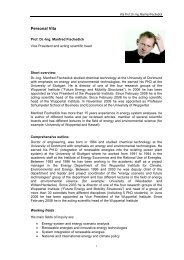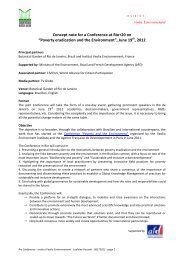Presentation Saskia Sassen - Institut Veolia Environnement
Presentation Saskia Sassen - Institut Veolia Environnement
Presentation Saskia Sassen - Institut Veolia Environnement
You also want an ePaper? Increase the reach of your titles
YUMPU automatically turns print PDFs into web optimized ePapers that Google loves.
Bridging the ecologies of<br />
cities and of nature<br />
<strong>Saskia</strong> <strong>Sassen</strong><br />
Columbia University<br />
http://www.columbia.edu/~sjs2/<br />
Beijing, Environment and Urbanization 09
Bridging the ecologies of cities and of<br />
nature<br />
• Cities are a type of socio-ecological system that has<br />
an expanding range of articulations with nature’s<br />
ecologies.<br />
• Today, most of these articulations produce<br />
environmental damage.<br />
• How we can begin to use these articulations to<br />
produce positive outcomes that allow cities to<br />
contribute to environmental sustainability.
Using complexity<br />
• The complex systemic and multi-scalar<br />
capacities of cities are a massive potential<br />
for a broad range of positive articulations<br />
with nature’s s complex ecologies.
Cities are at the center of the<br />
environmental future.<br />
• The massive processes of urbanization under<br />
way today are inevitably at the center of the<br />
environmental future.<br />
• It is through cities and vast urban<br />
agglomerations that humankind is increasingly<br />
present in the planet and through which it<br />
mediates its relation to the various stocks and<br />
flows of environmental capital.
The urban hinterland is now global<br />
• The urban hinterland was once a mostly<br />
confined geographic zone. Today it is a global<br />
hinterland.<br />
• The expansion of the global economy has<br />
raised our capacity to annex growing portions<br />
of the world to support a limited number of<br />
industries and places.
Two aspects of cities that matter:<br />
multi-scalar and many ecologies<br />
• Multi-scalar: The diverse terrains and domains,<br />
a) onto which cities project their effects and<br />
b) from which they meet their needs.<br />
• Ecologies of cities: a) Multiple mechanisms<br />
and feedback loops of urban processes. b)<br />
Articulations between these urban ecologies<br />
and nature’s s ecologies.
Cities create new socio-natural<br />
conditions.<br />
• The enormously distinctive presence that is<br />
urbanization is changing a growing range of<br />
nature’s s ecologies, from the climate to species<br />
diversity and ocean purity.<br />
• And it is creating new environmental<br />
conditions: heat islands, ozone holes,<br />
desertification, and water pollution.
Cities as new kinds of socio-<br />
ecological systems<br />
• As socio-ecological systems they often have<br />
planetary reach.<br />
For instance: The impact of cities on traditional rural<br />
economies and their long-standing cultural adaptation<br />
to biological diversity.<br />
• Rural populations have become consumers of<br />
products produced in the industrial economy, one<br />
much less sensitive to biological diversity.<br />
• The rural condition has evolved into a new system of<br />
social relations, one that does not work with<br />
biodiversity.
Is it urbanization per se or the<br />
particular types of urban systems<br />
• Is it agglomeration and density as such NO.<br />
• It is the contents we have historically and<br />
collectively produced: specific types of<br />
systems to handle it all: transport, waste<br />
disposal, building, heating and cooling, food<br />
provision, and the industrial process through<br />
which we extract, grow, make, package,<br />
distribute, and dispose of all the foods,<br />
services and materials we use.<br />
• And the processes of path-dependence which<br />
kept eliminating alternatives as we proceeded.
Re-orienting the material and<br />
organizational ecologies of cities<br />
• We need to use and build upon those features<br />
of cities that can re-orient orient the material and<br />
organizational ecologies of cities towards<br />
positive interactions with nature’s s ecologies.<br />
• These interactions, and the diversity of<br />
domains they cover, are themselves an<br />
emergent socio-ecological system that bridges<br />
the city’s s and nature’s s ecologies.
Specific features of cities that<br />
help re: environment<br />
• Economies of scale, density and the associated<br />
potential for greater efficiency in resource use.<br />
• Dense networks of communication that can<br />
serve as facilitators to institute<br />
environmentally sound practices in cities.<br />
• The temporal dimension becomes critical in<br />
environmentally sound initiatives: What is<br />
inefficient or value-losing losing according to market<br />
criteria with short temporal evaluation frames,<br />
is positive and value-adding adding using<br />
environment driven criteria.
.<br />
• Urban systems are built party through systems<br />
of social relations and laws that support the<br />
current configuration.<br />
• Beyond adoption of practices such as waste<br />
recycling, it will take a change in this system of<br />
social relations and the law itself to achieve<br />
greater environmental sensitivity and efficiency
The need to engage legal systems<br />
and profit logics<br />
• Urban sustainability requires engaging the legal<br />
systems and profit logics that underlie and<br />
enable many of the environmentally damaging<br />
aspects of our societies.<br />
• The question of urban sustainability cannot be<br />
reduced to modest interventions that leave these<br />
major systems untouched.<br />
• And the actual features of these systems vary<br />
across countries and across the North-South<br />
divide.
Non-scientific elements are very<br />
significant in cities<br />
• While in some of the other environmental<br />
domains it is indeed possible to confine the<br />
treatment of the subject to scientific knowledge,<br />
this is not the case when dealing with cities.<br />
• Non-scientific elements are a crucial part of the<br />
picture: questions of power, of poverty and<br />
inequality, ideology and cultural preferences, are<br />
all part of the question and the answer.
.<br />
• The city contains both, and in that regard can be described as<br />
instantiating a broad range of environmental damage that may<br />
involve very different scales and origins yet get constituted in<br />
urban terms: CO2 emissions produced by the micro-scale of<br />
vehicles and coal burning by individual households becomes<br />
massive air pollution covering the whole city with effects that go<br />
beyond CO2 emission per se.<br />
• Air and water borne microbes materialize as diseases at the scale<br />
of the household and the individual body and become epidemics<br />
thriving on the multiplier effects of urban density and capable of<br />
destabilizing operations of firms whose machines have no<br />
intrinsic susceptibility to the disease.
.<br />
• A second way in which the city is multiscalar is<br />
in the geography of the environmental damages<br />
it produces. Some of it is atmospheric, some of<br />
it internal to the built environment of the city, as<br />
might be the case with much sewage or disease,<br />
and some of it in distant locations around the<br />
globe, as with deforestation.
.<br />
• A third way in which the city can be seen as multiscalar<br />
is that its demand for resources can entail a geography<br />
of extraction and processing that spans the globe,<br />
though it does so in the form of a collection of<br />
confined individual sites, albeit sites distributed<br />
worldwide.<br />
• This worldwide geography of extraction instantiates in<br />
particular and specific forms (e.g. furniture, jewelry,<br />
machinery, fuel) inside the city. The city is one<br />
moment—the the strategic moment—in this global<br />
geography of extraction, and it is different from that<br />
geography itself.
.<br />
• a fourth way in which the city is multiscalar is that it<br />
instantiates a variety of policy levels. It is one of the key<br />
sites where a very broad range of policies—<br />
supranational, national, regional and local—materialize<br />
in specific procedures, regulations, penalties, forms of<br />
compliance and types of violations. These specific<br />
outcomes are different from the actual policies as they<br />
get designed and implemented at other levels of<br />
government.
In short…<br />
• Cities are complex systems in their geographies of consumption<br />
and of waste-production and this complexity also makes them<br />
crucial to the production of solutions. Some of the geographies<br />
for sound environmental action in cities will also operate<br />
worldwide. The network of global cities becomes a space at the<br />
global scale for the management of investments but also<br />
potentially for the re-engineering engineering of environmentally destructive<br />
global capital investments into more responsible investments. It<br />
contains the sites of power of some of the most destructive<br />
actors but potentially also the sites for demanding accountability<br />
ty<br />
of these actors. The scale of the network is different from the<br />
scale of the individual cities constituting this network.






